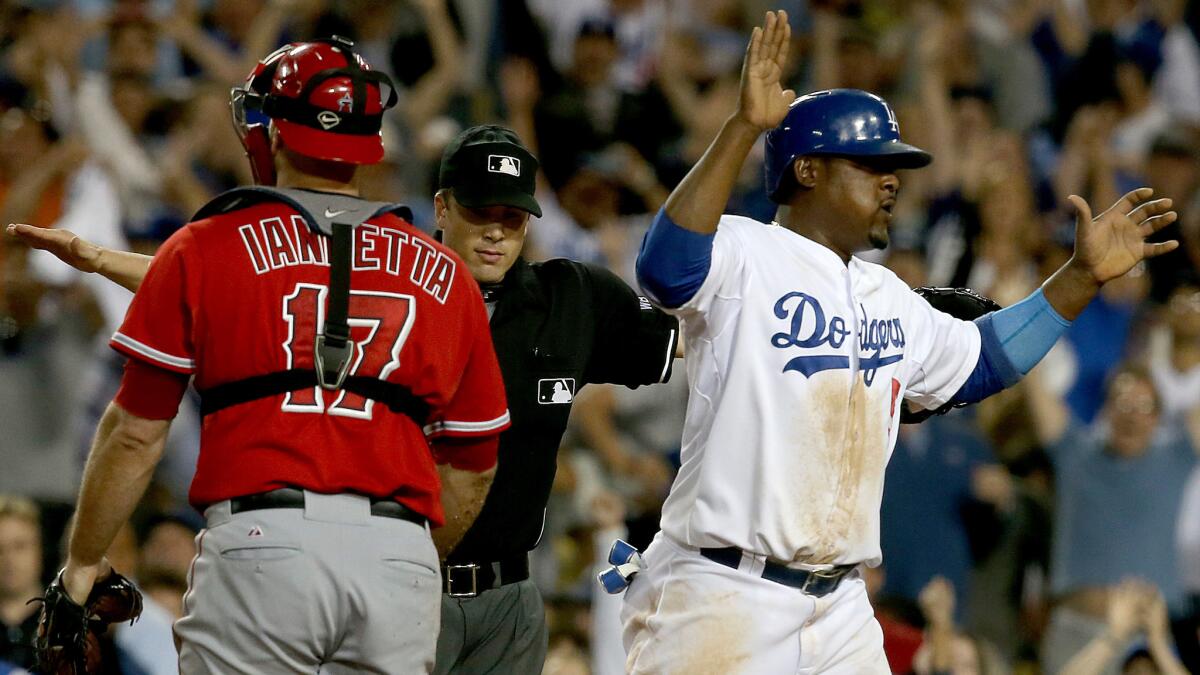Home-plate collision rule muddles Dodgers’ Tuesday win over Angels

- Share via
Chris Iannetta’s fear of violating the new home-plate collision rule may have prevented the Angels catcher from making the catch and tag on the game-ending play that gave the Dodgers a 5-4 victory over the Angels Tuesday night.
With the score tied, 4-4, runners on first and third and one out in the bottom of the ninth inning, Dodgers pinch-hitter Andre Ethier hit a slow chopper to Angels third baseman David Freese, who made a barehanded grab and fired home in an effort to nail Juan Uribe.
But Freese’s throw tailed toward the third-base line, and Iannetta, not wanting to block Uribe’s path to the plate without the ball, was a split-second late as he lunged to his left for the ball, which squirted out of his glove as Uribe collided with the mitt.
The rules allow Iannetta, who was set up to the right of the plate, to go into Uribe’s path if the throw takes him there, “but I held the lane too long,” he said. “I know what the rule is, that because the throw took me there, I could go into the lane. But the ball didn’t start off where it ended up. The ball tailed. I took an extra second to read the throw instead of going for it.”
Five months into the season, there is still pleny of confusion over Rule 7.13, which prohibits a runner from deviating from his direct path to the plate in order to initiate contact with the catcher and also prohibits catchers from blocking the plate without the ball.
But it’s not just the new rule that is causing the confusion; it’s how it is being interpreted by umpires and replay officials.
“There’s a lot of gray area,” said Angels Manager Mike Scioscia, the former Dodgers catcher who was known for his fearlessness in blocking the plate. “It’s supposed to be legal if Chris goes for the ball, but you never know what the interpretation of it is going to be from the replay official. Was he really going for the throw, or was he trying to block the path of the runner?
“It puts something in the back of your mind as to how aggressive you can be. If Chris was aggressive going after the ball [and made the play], there was a chance the call could be overturned. It’s a sensitive play. It’s going to be called sensitive from replay officials. It’s a different play than what I grew up with, for sure.”
Dodgers catcher A.J. Ellis said the play was a topic of discussion after the game.
“David Freese made a great play — it’s do or die,” Ellis said. “The catcher is really in a spot. Am I going to give the runner the baseline?”
Told that Angels catcher Hank Conger made the remark that every time a catcher has a play like that, he is thinking about the phone ringing in replay headquarters in New York City, Ellis said, “I totally agree.
“With me, it has been every play at the plate. You’re thinking, ‘Did I mistakenly block the runner’s path?’ You always have that moment of hesitation.”
More to Read
Go beyond the scoreboard
Get the latest on L.A.'s teams in the daily Sports Report newsletter.
You may occasionally receive promotional content from the Los Angeles Times.











